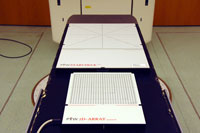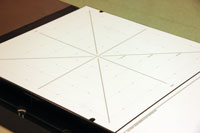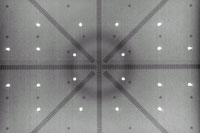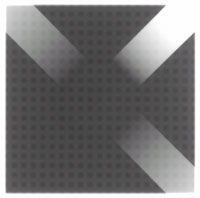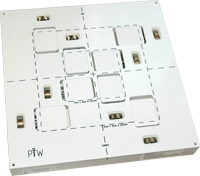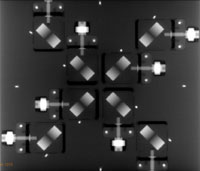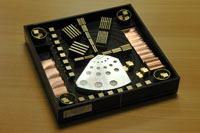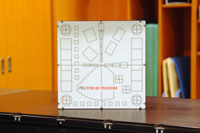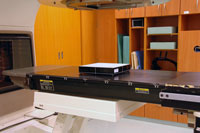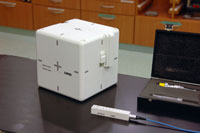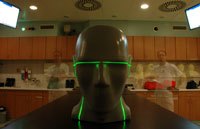Here, our QA equipment is listed in its operational context. There is also a tabular form.
Dosimetry Phantoms for Point Detectors
- In 2024, the new BEAMSCAN water phantom replaced the MP3 water phantom from 1996. Both phantoms can be used with detectors for relative dosimetry (section Point Detectors for Relative Dosimetry), and also for absolute dosimetry
with one of the verified and calibrated chambers.
- A small, manually operated 41023 water phantom for horizontal beams is used for energy constancy checks, external dosimetry audits, and chamber comparisons.
- A solid water (RW3) slab phantom with chamber holders for Roos, 0.3 cm3 and Farmer chambers is used for absolute dosimetry and calibration of in-vivo semiconductors.
- A home-made gantry-mounted PMMA-phantom, designed for a Farmer type chamber, is used for weekly linac QA.
- Our Model 009 Cube Phantom from CIRS accommodates a Farmer type chamber.
- The ESTRO Mini Phantom has a hole drilled for a 31013 thimble chamber.
Verified Dosemeters and Ionization Chambers
Three verified Unidos dosemeters are used for absolute dosimetry of therapy beams. Currently, 11 combinations of dosemeter (Unidos or Unidoswebline) and ionization chamber (Roos, 0.3 cm3, Farmer, or waterproof Farmer) are verified and calibrated every two years by an accredited calibration lab.
2D and 3D Dosimetry
The OCTAVIUS Detector 1500 with 1405 ionization chambers serves as gold standard for IMRT pretreatment verification. When it is used together with the modular OCTAVIUS 4D rotation unit, it provides full 3D dose measurement capability for all field sizes and dose rates (flattened and FFF beams).
The older OCTAVIUS Detector 729 2D Array is still available, and is used for machine QA.
The inhomogeneity correction capability of TPS algorithms can by checked with the Inhomogeneity phantom T40037 on top of the 2D-Array. It has inserts with densities of Lung, Tissue, PMMA and Bone.
The aS1200 amorphous silicon detectors (DMI detectors) of the TrueBeam are used for IMRT pretreatment verification with two software solutions:
- either in the integrated Varian Portal Dosimetry environment (Portal Dose Prediction Algorithm in Eclipse + Portal Dosimetry Workspace in ARIA)
- or with the EPIQA Software, which employs the GLAaS algorithm (see our experiences with unflattened and flattened beams).
With the Model 605 Radiosurgery Head Phantom from CIRS, stereotactic dose distributions in the head can be verified. It can be loaded with a GafChromic film stack (2.5" x 2.5" x 2.5"). For evaluating films, an Epson 10000XL (A3 format) flatbed scanner is available.
1D-Dosimetry (Linear Array)
The LA48 Linear Array is not used on a regular basis. But it is the only practical device for the verification of EDW wedge angles in water (for most other applications, the LA48 has been
superseeded by 2D-Arrays).
The fast
measurement mode, where 100 beam profiles per second are acquired,
is used to assess the linac startup behaviour. The LA48 can be either operated
in the MP3 water phantom (the LA48 is not compatible with BEAMSCAN) or with the
AirScanner, which is attached to the linac head.
Linac QA
Two QUICKCHECKwebline (QCw) devices are in daily use on the TrueBeams. During morning checkout, the parameters dose output, inplane/crosplane symmetry, flatness and energy constancy are measured on a single shot for each of the 11 energies. During yearly QA, our vintage QUICKCHECKs are used together with the Gantry holder to evaluate beam symmetry for all Gantry angles. QCw is operated via Quickcheck 1.5 software, QUICKCHECK via QC-Win software (not 64bit compatible!) running on old XP-laptops.
The BQ-CHECK test object and the OCTAVIUS Detector 1500 can be used to check beam quality of photon and electron beams.
The STARCHECKmaxi can be used up to a maximum field size of 40 x 40 cm. It has two main applications on the TrueBeam:
- to check and document beam symmetry for all energies, acording to national QA protocols. In this context, the STARCHECKmaxi is used with MultiCheck software. All profile parameters (e.g., inplane/crossplane symmetry, CAX deviations, field size, ...) plus absolute dose are recorded in a single shot. MultiCheck keeps track of all measurements.
- The second important application is when beam symmetry has to be adjusted on the TrueBeam. If beam symmetry improves when the Angle servos gets turned OFF, the Angle radial or transverse servos only need to be calibrated (the most common case). If measured symmetry is poor with and without Angle servo, the servo points have to be adjusted. In both cases the STARCHECKmaxi is used with BeamAdjust software, to make the necessary beam steering adjustments in real-time. Measurements have to be saved as single files.
MultiCheck software also understands setups where the FIELDCHECK test object1 is placed on top of STARCHECKmaxi. With this combination, light field/radiation field congruence can be measured with high accuracy. See our experiences after one year of use.
The QUASAR Penta-Guide Phantom from Modusmed is a valuable tool for checking pitch and roll online corrections introduced in 2014 with TrueBeam 2.0 and the Varian PerfectPitch couch. In addition to this, the phantom is ideal for checking IGRT workflows with and without respiratory gating.
MV- and kV-Image magnification factors at four gantry angles according to ONORM S5290-3 are checked with the Civco Iso-Align Phantom.
The latest (2020) addition is the RUBY phantom from PTW, which is mainly used for end-to-end testing of the treatment chain.
EPID QA
The image quality of the Varian amorphous silicon portal imager (aS1000) is checked regularly with the EPID QC phantom. It's worth looking under the hood of the EPID QC phantom (see sidebar).
Evaluation of the acquired images is done with epidSoft. The software detects the image corners and performs the evaluation automatically (see our experiences with automatic registration).
kV QA
The department's X-ray devices currently include a CT and the TrueBeam kV imager.
Two Catphan 504 are used for CBCT on the TrueBeams, one Catphan 600 on the CT scanner. All CBCT and CT images are evaluated with AutoQA Plus software from QA Benchmark.
Tube voltages (kVpeak, kVmean, Practical Peak Voltage) are measured non-invasively with a DIAVOLT Universal and logged with DiaControl expert software.
Air Kerma can either be measured with the DIAVOLT, with the (verified and calibrated) Diados diagnostic dosemeter and a diagnostic detector, or with the Unidoswebline and the SFD Diagnostic Chamber PTW TM34060-2,5 (75 cm3).
For CTDI measurements a CTDI Set (PMMA Head & Body phantom + CT chamber + Unidoswebline) is available.
HVL is measured with a High-Purity Filter Set consisting of 13 copper and 8 aluminum filters. The 99.9% Cu-filters are between 0.01mm and 10mm thick (13 filters, total thickness 21.269mm), the 99.99% Al filters range from 0.1mm to 10mm (8 filters, total thickness 15.859mm).
Image quality of the TrueBeam's kV imaging system is checked with Normi 13 and the Leeds TOR 18FG test object.
Patient (in-Vivo) Dosimetry
Patient dosimetry is performed on the linacs using semiconductors from Sun Nuclear and PTW. On each linac, 12 diodes (6 for 6MV and 6 for 15MV) can be drawn from the mobile Diode Mate carts from PTW. For Electron energies, there are 6 electron diodes available. All semiconductors are connected to Multidos dosemeters. Measurement software is MultiSoft.
Respiratory Motion QA
A large bore CT (Toshiba AquilionLB) is in clinical use in our department since March 2011. It has prospective and retrospective gating capability. TrueBeam provides Gating capability too.
To assure the quality of this functionality, two phantoms from Modusmed are available:
- The QUASAR Respiratory Motion Platform is a general purpose platform which is computer controlled and applies periodic motion to any phantom.
- The CATPHAN Shaker does the same with the well-known CATPHAN phantom, so it makes it possible to check CT imaging performance under gating conditions.
Both phantoms are controlled by Respiratory Motion Software from Modusmed.
Special Software
EPIQA by Radiqa Developments SA (formerly epidos) was already mentioned above. It is not only used for IMRT and RapidArc pretreatment verification but also for Linac QA.
The DIAMOND secondary check software has been in use for independent dose calculation of RapidArc and IMRT plans since 2014, and was replaced by VERIQA in 20242.
AutoQA Plus is used for automated evaluation of CT and CBCT images. QALite is a product of QA Benachmark, LLC (formerly IrisQA, LLC).
Notes
1 FIELDCHECK was designed by Thijs Perik from The Netherlands Cancer Institute - Antoni van Leeuwenhoek Hospital, Amsterdam.
2 Since July 2024, pretreatment patient plan QA is exclusively performed with VERIQA.
